Samsung 330TFT, 531 TFT, 331 TFT, 530 TFT User Manual
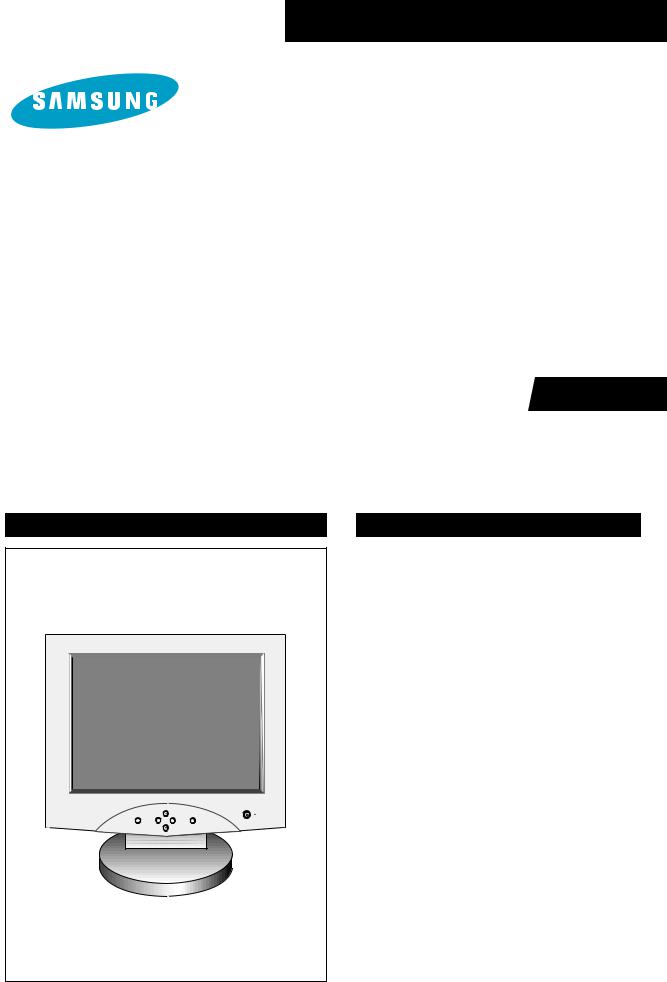
COLOR MONITOR
SyncMaster 330TFT
SyncMaster 530TFT
SyncMaster 331TFT
SyncMaster 531TFT
SERVICEManual
COLOR MONITOR
SAMSUNG |
|
EXIT |
MENU |
- |
+ |
1.Precautions
2.Reference Information
3.Product Specifications
4.Operating Instructions
5.Disassembly & Reassembly
6.Troubleshooting
7.Exploded View & Parts
8.Block Diagram
9.Electrical Parts List
10.PCB Diagrams
11.Wiring Diagram
12.Schematic Diagrams

Samsung Electronics Co., Ltd. July 1998
Printed in Korea
Code No.: BN68-60017A
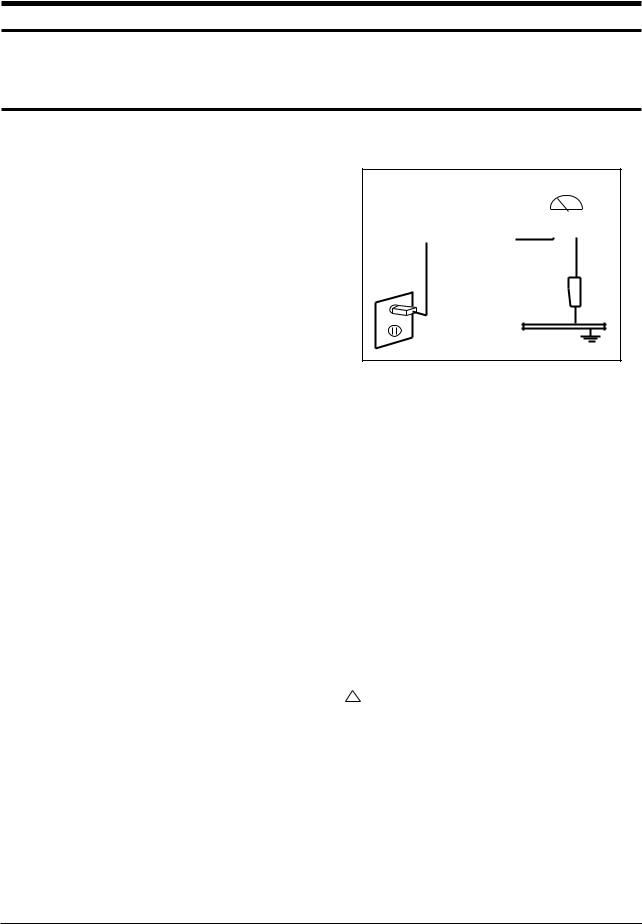
1 Precautions
Follow these safety, servicing and ESD precautions to prevent damage and to protect against potential hazards such as electrical shock.
1-1 Safety Precautions
1-1-1 Warnings
1.For continued safety, do not attempt to modify the circuit board.
2.Disconnect the AC power and DC Power Jack before servicing.
3.When the chassis is operating, semiconductor heatsinks are potential shock hazards.
|
|
|
(READING SHOULD |
|||
|
|
|
NOT BE ABOVE 0.5mA) |
|||
|
|
|
|
|
|
|
|
|
|
|
|
|
|
|
|
|
|
LEAKAGE |
|
|
DEVICE |
|
|
|
|
||
|
|
|
CURRENT |
|
||
UNDER |
|
|
|
|
||
|
|
|
TESTER |
|
||
TEST |
|
|
|
|
|
|
|
|
TEST ALL |
||||
|
EXPOSED METAL |
|||||
|
|
SURFACES |
||||
1-1-2 Servicing the LCD Monitor
1.When servicing the LCD Monitor, remove the static charge by connecting a 10k ohm resistor in series with an insulated wire (such as a test probe) between the chassis and the anode lead. (Disconnect the AC line cord from the AC outlet.)
2.It is essential that service technicians have an accurate voltage meter available at all times. Check the calibration of this meter periodically.
1-1-3 Fire and Shock Hazard
Before returning the monitor to the user, perform the following safety checks:
1.Inspect each lead dress to make certain that the leads are not pinched or that hardware is not lodged between the chassis and other metal parts in the monitor.
2.Inspect all protective devices such as nonmetallic control knobs, insulating materials, cabinet backs, adjustment and compartment covers or shields, isolation resistor-capacitor networks, mechanical insulators, etc.
3.Leakage Current Hot Check (Figure 1-1): WARNING:
Do not use an isolation transformer during this test.
Use a leakage current tester or a metering system that complies with American National Standards Institute (ANSI C101.1, Leakage Current for Appliances), and Underwriters Laboratories (UL Publication UL1410, 59.7).
2-WIRE CORD
ALSO TEST WITH
PLUG REVERSED
(USING AC ADAPTER
PLUG AS REQUIRED) EARTH GROUND
Figure 1-1. Leakage Current Test Circuit
4.With the unit completely reassembled, plug the AC line cord directly into a 120V AC outlet. With the unit’s AC switch first in the ON position and then OFF, measure the current between a known earth ground (metal water pipe, conduit, etc.) and all exposed metal parts, including: metal cabinets, screwheads and control shafts. The current measured should not exceed 0.5 milliamp. Reverse the power-plug prongs in the AC outlet and repeat the test.
1-1-4 Product Safety Notices
Some electrical and mechanical parts have special safety-related characteristics which are often not evident from visual inspection. The protection they give may not be obtained by replacing them with components rated for higher voltage, wattage, etc. Parts that have special safety characteristics are identified by
! on schematics and parts lists. A substitute replacement that does not have the same safety characteristics as the recommended replacement part might create shock, fire and / or other hazards. Product safety is under review continuously and new instructions are issued whenever appropriate.
SyncMaster 33*TFT/53*TFT |
1-1 |

1 Precautions
1-2 Servicing Precautions
WARNING: An electrolytic capacitor installed with the wrong polarity might explode.
Caution: Before servicing units covered by this service manual, read and follow the Safety Precautions section of this manual.
Note: If unforeseen circumstances create conflict between the following servicing precautions and any of the safety precautions, always follow the safety precautions.
1-2-1 General Servicing Precautions
1.Always unplug the unit’s AC power cord from the AC power source and disconnect the DC Power Jack before attempting to:
(a)remove or reinstall any component or assembly,
(b)disconnect PCB plugs or connectors, (c) connect a test component in parallel with an electrolytic capacitor.
2.Some components are raised above the printed circuit board for safety. An insulation tube or tape is sometimes used. The internal wiring is sometimes clamped to prevent contact with thermally hot components. Reinstall all such elements to their original position.
3.After servicing, always check that the screws, components and wiring have been correctly reinstalled. Make sure that the area around the serviced part has not been damaged.
4.Check the insulation between the blades of the AC plug and accessible conductive parts (examples: metal panels, input terminals and earphone jacks).
5.Insulation Checking Procedure: Disconnect the power cord from the AC source and turn the power switch ON. Connect an insulation resistance meter (500 V) to the blades of the AC plug.
The insulation resistance between each blade of the AC plug and accessible conductive parts (see above) should be greater than 1 megohm.
6.Always connect a test instrument’s ground lead to the instrument chassis ground before connecting the positive lead; always remove the instrument’s ground lead last.
1-3 Electrostatically Sensitive Devices (ESD) Precautions
Some semiconductor (solid state) devices can be easily damaged by static electricity. Such components are commonly called Electrostatically Sensitive Devices (ESD). Examples of typical ESD devices are integrated circuits and some fieldeffect transistors. The following techniques will reduce the incidence of component damage caused by static electricity.
1.Immediately before handling any semiconductor components or assemblies, drain the electrostatic charge from your body by touching a known earth ground. Alternatively, wear a discharging wriststrap device. To avoid a shock hazard, be sure to remove the wrist strap before applying power to the monitor.
2.After removing an ESD-equipped assembly, place it on a conductive surface such as aluminum foil to prevent accumulation of an electrostatic charge.
3.Do not use freon-propelled chemicals. These can generate electrical charges sufficient to damage ESDs.
4.Use only a grounded-tip soldering iron to solder or desolder ESDs.
5.Use only an anti-static solder removal device. Some solder removal devices not classified as “anti-static” can generate electrical charges sufficient to damage ESDs.
6.Do not remove a replacement ESD from its protective package until you are ready to install it. Most replacement ESDs are packaged with leads that are electrically shorted together by conductive foam, aluminum foil or other conductive materials.
7.Immediately before removing the protective material from the leads of a replacement ESD, touch the protective material to the chassis or circuit assembly into which the device will be installed.
Caution: Be sure no power is applied to the chassis or circuit and observe all other safety precautions.
8.Minimize body motions when handling unpackaged replacement ESDs. Motions such as brushing clothes together, or lifting your foot from a carpeted floor can generate enough static electricity to damage an ESD.
1-2 |
SyncMaster 33*TFT/53*TFT |

2 Reference Information
2-1 List of Abbreviations, Symbols and Acronyms
2-1-1 Abbreviations
Abbreviation |
Definition |
|
|
AUTO_MENB |
AUTO ENABLE (NEG.) |
AUTO_SOG |
SINK ON GREEN ENABLE |
BL_EN |
LCD PANEL BACK LIGHT ENABLE |
BRIGHT |
BRIGHTNESS CONTROL |
DAB(7:0) |
BLUE COLOR DATA (ODD) FROM IC305 |
DAG(7:0) |
GREEN COLOR DATA (ODD) FROM IC305 |
DAR(7:0) |
RED COLOR DATA (ODD) FROM IC305 |
DBB(7:0) |
BLUE COLOR DATA (EVEN) FROM IC305 |
DBG(7:0) |
GREEN COLOR DATA (EVEN) FROM IC305 |
DBR(7:0) |
RED COLOR DATA (EVEN) FROM IC305 |
DDC_SCL |
DDC I2C CLOCK FROM PC |
DDC_SDA |
DDC I2C DATA FROM PC |
DEN |
LVDS DATA ENABLE |
DFSYNCB |
CONTROL SIGNAL FROM IC301 TO IC305 |
DHCLK |
DOT CLOCK FOR PANEL DRIVING |
DHS |
LVDS HSYNC |
DREFCLK1 |
67MHz OSC CLK FOR IC305 |
DV_BLU |
OSD BLUE DATA |
DV_FBK |
OSD ENABLE |
DV_GRN |
OSD GREEN DATA |
DV_RED |
OSD RED DATA |
DVACTIV1B |
HSYNC FOR OSD (NEG.) |
DVCLK |
DOT CLOCK FOR OSD |
DVS |
LVDS VSYNC |
DVSYNCB |
VSYNC FOR OSD (NEG.) |
FSD(47:0) |
VIDEO DATA BETWEEN IC301 AND |
|
IC302,IC303,IC304 |
HSYNC_PLL |
HSYNC FOR PLL |
INVERT |
INTERLACE CONTROL SIGNAL |
KEY1 |
FUNCTION KEY SIGNAL1 TO MICOM |
KEY2 |
FUNCTION KEY SIGNAL2 TO MICOM |
LED |
LED ON |
LVDS_DATA |
DATA OUTPUT FROM IC310, IC311 |
LVDS_EN |
LVDS ENABLE |
M_HSYNC |
BUFFERED MICOM OUTPUT HSYNC |
M_HSYNC1 |
MICOM OUTPUT HSYNC |
M_VSYNC |
BUFFERED MICOM OUTPUT VSYNC |
M_VSYNC1 |
MICOM OUTPUT VSYNC |
OSCOUT |
BUFFERED 24MHz CLOCK |
|
|
Abbreviation |
Definition |
|
|
OSCOUT1 |
24MHz CLOCK |
PANEL_EN |
+12V_PANEL/+5V_PANEL ENABLE |
PC_BLUE_IN |
BLUE COLOR SIGNAL FROM PC |
PC_GREEN_IN |
GREEN COLOR SIGNAL FROM PC |
PC_HSYNC_IN |
HSYNC FROM PC |
PC_RED_IN |
RED COLOR SIGNAL FROM PC |
PC_VSYNC_IN |
VSYNC FROM PC |
PCBLUE(7:0) |
BLUE COLOR DATA FROM IC101 |
PCCLAMP |
BUFFERED VIDEO CLAMP SIGNAL |
PCCLAMP1 |
VIDEO CLAMP SIGNAL |
PCCLK |
PLL CLOCK OUT FOR IC301 |
PCCLK2 |
PLL CLOCK OUT FOR IC405 |
PCCLK3 |
PLL CLOCK OUT FOR IC110 |
PCGREEN(7:0) |
GREEN COLOR DATA FROM ADC(IC101) |
PCRED(7:0) |
RED COLOR DATA FROM IC101 |
PCVSYNC2 |
BUFFERED VSYNC |
RESETB |
RESET (NEG.) |
RGB_HSYNC |
HSYNC FOR MICOM(IC401) |
RGB_VSYNC |
VSYNC FOR MICOM(IC401) |
SCL |
I2C CLOCK |
SCSB |
IC305 ENABLE |
SDA |
I2C DATA |
SOG_CSYNC |
COMPOSITE SYNC FROM SOG |
SOURCE_PC |
SELF RASTER CHECK SIGNAL |
SPI_MISO |
SERIAL INPUT DATA CONTROL |
SPI_MOSI |
SERIAL OUTPUT DATA CONTROL |
SPI_SCK |
SERIAL CLOCK |
SW_REG_ENB |
POWER ON/OFF CONTROL |
VAIL_CSB |
IC301 ENABLE |
VCBLNKB |
CONTROL SIGNAL FROM IC305 TO IC301 |
VCC |
DC 5V FOR MICOM(IC401) |
VCLREQB |
CONTROL SIGNAL FROM IC305 TO IC301 |
VGABLUE(7:0) |
NC |
VGAGREEN(7:0) |
NC |
VGARED(7:0) |
NC |
VGBBLUE(7:0) |
BLUE COLOR DATA FROM IC301 |
VGBGREEN(7:0) |
GREEN COLOR DATA FROM IC301 |
VGBRED(7:0) |
RED COLOR DATA FROM IC301 |
|
|
SyncMaster 33*TFT/53*TFT |
2-1 |

2 Reference Information
2-1-2 Symbols
Hot Ground
Cold Ground
!Provides special safety considerations
2-1-2 Acronyms
Acronym |
Definition |
|
|
ABL |
Automatic Brightness Limits |
AC |
Alternating Current |
ACL |
Automatic Contrast Limit |
AFC |
Automatic Frequency Control |
ANSI |
American National Standards Institute |
CMOS |
Complementary Metal Oxide |
|
Semiconductor |
CRT |
Cathode Ray Tube |
DC |
Direct Current |
DDC |
Data Display Channel |
DF |
Dynamic Focus |
DMM |
Digital Multimeter |
DPMS |
Display Power Management Signaling |
DVM |
Digital Voltmeter |
DY |
Deflection Yoke |
EEPROM |
Electrically Erasable and |
|
Programmable Read only Memory |
ESD |
Electrostatically Sensitive Device |
ESF |
Electronic Static Field |
FBT |
Flyback Transformer |
FET |
Field Effect Transistor |
FH |
Horizontal Frequency |
FS |
Fail Safe |
FV |
Vertical Frequency |
GD |
Geometric Distortion |
|
|
Acronym |
Definition |
|
|
H/V |
Horizontal/Vertical |
HV |
High Voltage |
I/O |
Input/Output |
IC |
Integrated Circuit |
LED |
Light Emitting Diode |
MAC |
Macintosh |
MOFA |
Mask Outside Frame Assembly |
OCP |
Over Current Protection |
OP AMP |
Operational Amplifier |
OSD |
On Screen Display |
P-P |
Peak to Peak |
PCB |
Printed Circuit Board |
PLL |
Phase Locked Loop |
PWM |
Pulse Width Modulation |
SMPS |
Switch Mode Power Supply |
SVGA |
Super Video Graphics Array |
TP |
Test Point |
UL |
Underwriters Laboratories |
USB |
Universal Serial Bus |
VESA |
Video Electronics Standard |
|
Association |
VGA |
Video Graphics Array |
VR |
Variable Registor |
W/B |
White Balance |
|
|
2-2 |
SyncMaster 33*TFT/53*TFT |

3 Product Specifications
3-1 Specifications
Item |
|
|
|
Description |
|
|
|
||||
LCD Panel |
TFT-LCD panel, RGB vertical stripe, normaly white, 15-Inch viewable, |
||||
|
0.297 (H) x 0.297 (V) pixel pitch, 13.3-Inch viewable, 0.264 (H) x 0.264 (V) pixel pitch |
||||
|
|
|
|||
Scanning Frequency |
Horizontal : 30 kHz to 61 kHz (Automatic) |
|
|||
|
Vertical |
: 50 Hz to 75 Hz (Automatic) |
|
||
|
|
|
|
|
|
Display Colors |
16.7 Million colors |
|
|
|
|
|
|
|
|
|
|
Maximum Resolution |
Horizontal : 1024 Pixels |
|
|
|
|
|
Vertical |
: 768 Pixels |
|
|
|
|
|
|
|||
Input Video Signal |
Analog, 0.714 Vp-p ± 5% positive at 75 Ω , internally terminated |
||||
|
|
|
|
||
Input Sync Signal |
Type: |
Seperate H/V sync, Composite H/V, Sync-on-Green, automatic synchronization |
|||
|
|
without external switch of sync type |
|
||
|
Level: |
TTL level |
|
|
|
|
|
|
|
|
|
Maximum Pixel Clock rate |
80 MHz |
|
|
|
|
|
|
|
|
||
Active Display |
13.3”: 270.3 mm / 207.8 mm |
|
|
||
Horizontal/Vertical |
15”: 304.1 mm / 228.1 mm |
|
|
||
|
|
|
|||
AC power voltage & Frequency |
AC 90 to 264 Volts, 60/ 50 Hz ± 3 Hz |
|
|||
|
|
|
|||
Power Consumption |
13.3”: 40 W (max.), 15”: 45 W (max.) |
|
|||
|
|
|
|
|
|
Dimensions |
|
13.3” |
|
|
15” |
Unit (W x D x H) |
13.9x7.7x15.6 Inches (354.3 x 195.6 x 395 mm) |
15.9x7.7x16.5 Inches (404 x 196.6 x 418.7 mm) |
|||
Carton (W x D x H) |
17.9 x 11.1 x 19.2 Inches (455 x 282 x 488 mm) |
18.7 x 11.1 x 20.1 Inches (475 x 282 x 510 mm) |
|||
|
|
|
|
|
|
Weight |
|
|
|
|
|
(Net/Gross) |
13.3”: 6.4 kg / 8.0 kg, 15”: 7.5 kg / 9.5 kg |
|
|||
|
|
|
|
|
|
Environmental Considerations |
Operating Temperature |
: |
50°F to 104°F (10°C to 40°C) |
||
|
Humidity : 10 % to 80 % |
|
|
||
|
Storage Temperature |
: |
-13°F to 113°F (-25°C to 45°C) |
||
|
Humidity : 5 % to 95 % |
|
|
|
|
|
|
|
|
|
|
Audio Characteristics |
• Audio Characteristics |
|
|
|
|
|
• Built-in Microphone: High-sensitivity condenser microphone (mono) |
||||
|
• Audio input: Left/Right Stereo phone jack, 0.7 Vrms |
||||
|
• Sound output: 1 W (left) + 1 W (right)/THD 1% at 8ohm |
||||
|
• Frequency response: 80 Hz~20 kHz (at –3dB) |
|
|||
|
• Headphone: Max 50mW output (3.5-pi jack) |
|
|||
|
• Speaker: Internal semi Dome (8ohm x 2) |
|
|||
|
|
|
|||
• SyncMaster 33*TFT/53*TFT complies with SWEDAC (MPR II) recommendations for reduced electromagnetic fields. |
|||||
• Designs and specifications are subject to change without prior notice. |
|
||||
|
|
|
|
|
|
SyncMaster 33*TFT/53*TFT |
3-1 |
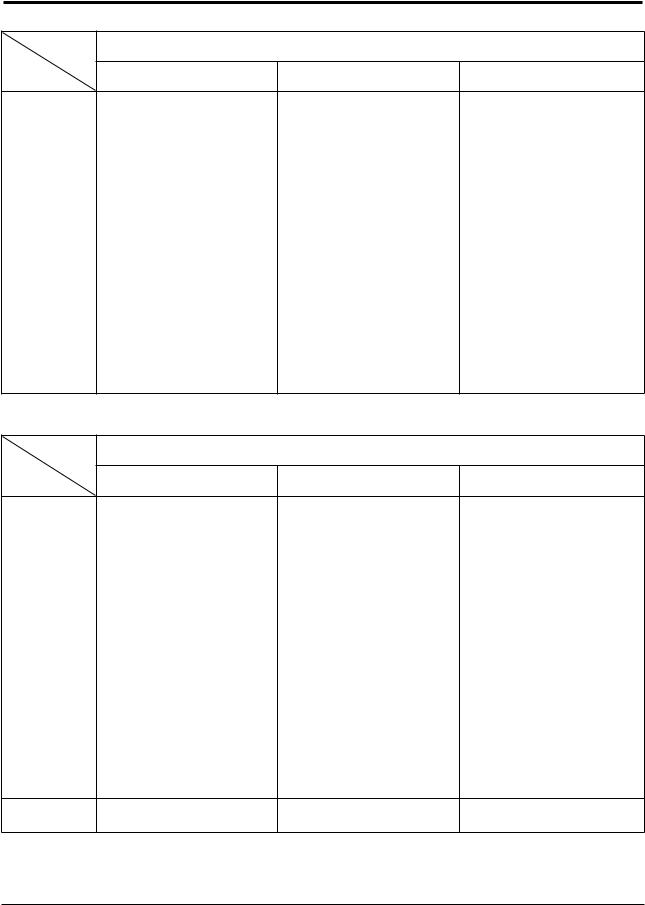
3 Product Specifications
3-2 Pin Assignments |
|
|
|
|
Sync |
15-Pin Signal Cable Connector |
|
|
Type |
|
|
Pin No. |
Separate |
Composite |
Sync-on-green |
|
|
|
|
1 |
Red |
Red |
Red |
2 |
Green |
Green |
Green + H/V Sync |
3 |
Blue |
Blue |
Blue |
4 |
GND |
GND |
GND |
5 |
GND (DDC Return) |
GND (DDC Return) |
GND (DDC Return) |
6 |
GND-R |
GND-R |
GND-R |
7 |
GND-G |
GND-G |
GND-G |
8 |
GND-B |
GND-B |
GND-B |
9 |
No Connection |
No Connection |
Not Used |
10 |
GND-Sync/Self Test |
GND-Sync/Self Test |
GND-Sync/Self Test |
11 |
GND |
GND |
GND |
12 |
DDC Data |
DDC Data |
DDC Data |
13 |
H-Sync |
H/V-Sync |
Not Used |
14 |
V-Sync |
Not Used |
Not Used |
15 |
DDC Clock |
DDC Clock |
DDC Clock |
Sync |
|
26-Pin Signal Cable Connector |
|
Type |
|
|
|
Pin No. |
Separate |
Composite |
Sync-on-green |
|
|
|
|
1 |
Red |
Red |
Red |
2 |
Green |
Green |
Green + H/V Sync |
3 |
Blue |
Blue |
Blue |
4 |
GND |
GND |
GND |
5 |
GND (DDC Return) |
GND (DDC Return) |
GND (DDC Return) |
6 |
GND-R |
GND-R |
GND-R |
7 |
GND-G |
GND-G |
GND-G |
8 |
GND-B |
GND-B |
GND-B |
9 |
No Connection |
No Connection |
Not Used |
10 |
GND-Sync/Self Test |
GND-Sync/Self Test |
GND-Sync/Self Test |
11 |
GND |
GND |
GND |
12 |
DDC Data |
DDC Data |
DDC Data |
13 |
H-Sync |
H/V-Sync |
Not Used |
14 |
V-Sync |
Not Used |
Not Used |
15 |
DDC Clock |
DDC Clock |
DDC Clock |
16 ~26 |
GND |
GND |
GND |
3-2 |
|
|
SyncMaster 33*TFT/53*TFT |
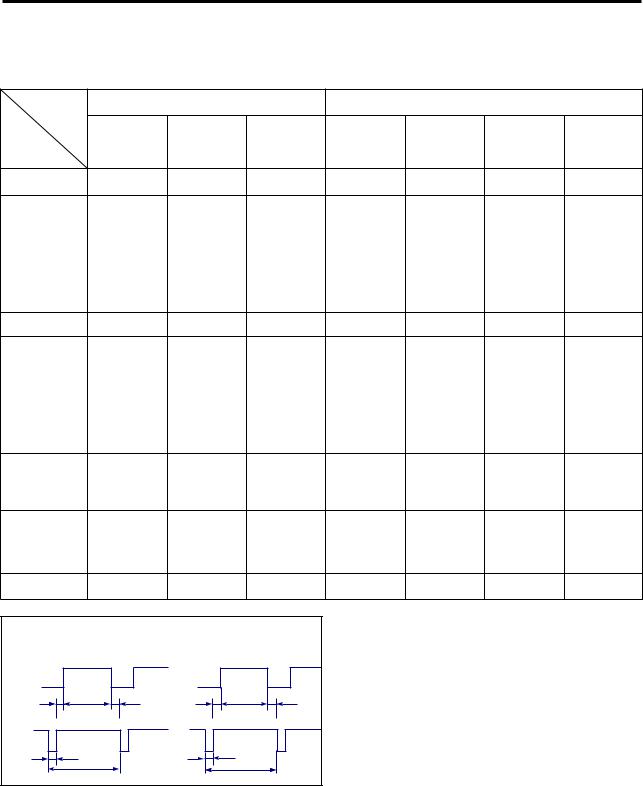
3 Product Specifications
3-3 Timing Chart
This section of the service manual describes the timing that the computer industry recognizes as standard for computer-generated video signals.
Table 3-1. Timing Chart
Mode |
|
IBM |
|
|
|
VESA |
|
|
VGA1/70 Hz |
VGA2/70 Hz |
VGA3/60 Hz |
640/72 Hz |
640/75 Hz |
800/56 Hz |
800/60 Hz |
Timing |
640 x 350 |
720 x 400 |
640 x 480 |
640 x 480 |
640 x 480 |
800 x 600 |
800 x 600 |
|
|
|
|
|
|
|
|
fH (kHz) |
31.469 |
31.469 |
31.469 |
37.861 |
37.500 |
35.156 |
37.879 |
A µsec |
31.778 |
31.777 |
31.778 |
26.413 |
26.667 |
28.444 |
26.400 |
B µsec |
3.813 |
3.813 |
3.813 |
1.270 |
2.032 |
2.000 |
3.200 |
C µsec |
1.589 |
1.589 |
1.589 |
3.810 |
3.810 |
3.556 |
2.200 |
D µsec |
26.058 |
26.058 |
26.058 |
20.825 |
20.317 |
22.222 |
20.000 |
E µsec |
0.318 |
0.318 |
0.318 |
0.508 |
0.508 |
0.667 |
1.000 |
fV (Hz) |
70.086 |
70.087 |
59.940 |
72.809 |
75.000 |
56.250 |
60.317 |
O msec |
14.268 |
14.268 |
16.683 |
13.735 |
13.333 |
17.778 |
16.579 |
P msec |
0.064 |
0.064 |
0.064 |
0.079 |
0.080 |
0.057 |
0.106 |
Q msec |
1.716 |
0.858 |
0.794 |
0.528 |
0.427 |
0.626 |
0.607 |
R msec |
11.504 |
13.155 |
15.761 |
13.100 |
12.800 |
17.067 |
15.840 |
S msec |
0.985 |
0.191 |
0.064 |
0.026 |
0.027 |
0.028 |
0.026 |
Clock |
|
|
|
|
|
|
|
Frequency |
25.175 |
28.322 |
25.175 |
31.500 |
31.500 |
36.000 |
40.000 |
(MHz) |
|
|
|
|
|
|
|
Polarity |
|
|
|
|
|
|
|
H.Sync |
Positive |
Negative |
Negative |
Negative |
Negative |
Positive |
Positive |
V.Sync |
Negative |
Positive |
Negative |
Negative |
Negative |
Negative |
Positive |
Remark |
Separate |
Separate |
Separate |
Separate |
Separate |
Separate |
Separate |
|
|
Separate Sync |
|
|
|
Horizontal |
|
|
Vertical |
|
|
Video |
|
|
Video |
|
|
C C |
DD |
E E |
Q Q |
R R |
S S |
Sync |
|
|
Sync |
|
|
|
B |
|
|
PP |
|
|
B |
|
|
|
|
|
A A |
|
|
O O |
|
A : Line time total |
B : Horizontal sync width |
O : Frame time total |
P : Vertical sync width |
C : Back porch |
D : Active time |
Q : Back porch |
R : Active time |
E : Front porch |
|
S : Front porch |
|
|
|
|
|
|
|
|
|
SyncMaster 33*TFT/53*TFT |
3-3 |
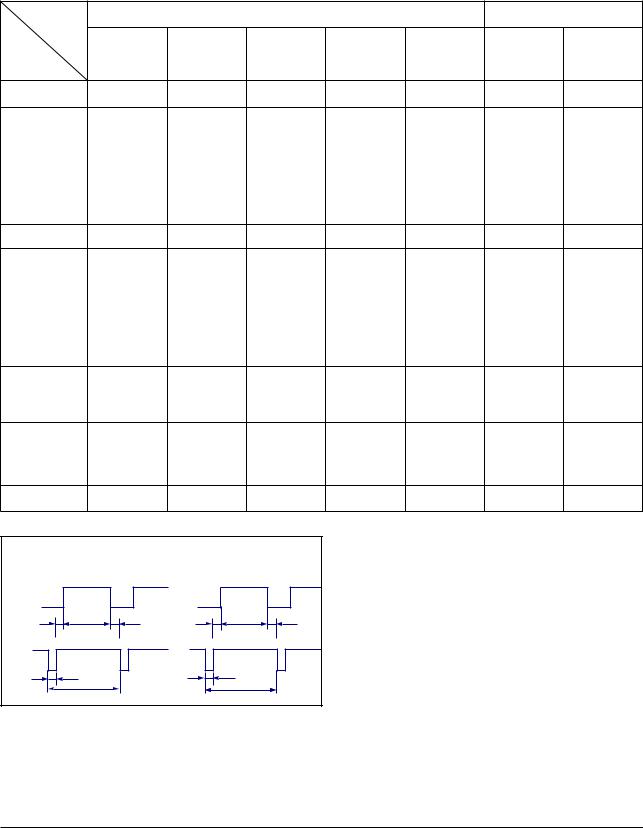
3 Product Specifications
Table 3-1. Timing Chart Continued
Mode |
|
|
VESA |
|
|
|
MAC. |
|
800/72 Hz |
800/75 Hz |
1024/60 Hz |
1024/70 Hz |
1024/75 Hz |
640/67 Hz |
832/75 Hz |
Timing |
800 x 600 |
800 x 600 |
1024 x 768 |
1024 x 768 |
1024 x 768 |
60 x 480 |
832 x 624 |
|
|
|
|
|
|
|
|
fH (kHz) |
48.077 |
46.875 |
48.363 |
56.476 |
60.023 |
35.000 |
49.726 |
A µsec |
20.800 |
21.333 |
20.677 |
17.707 |
16.660 |
28.571 |
20.110 |
B µsec |
2.400 |
1.616 |
2.092 |
1.813 |
1.219 |
2.116 |
1.117 |
C µsec |
1.280 |
3.232 |
2.462 |
1.920 |
2.235 |
3.175 |
3.910 |
D µsec |
16.000 |
16.162 |
15.754 |
13.653 |
13.003 |
21.164 |
14.524 |
E µsec |
1.120 |
0.323 |
0.369 |
0.320 |
0.203 |
2.116 |
0.559 |
fV (Hz) |
72.188 |
75.000 |
60.004 |
70.069 |
75.029 |
66.667 |
74.551 |
O msec |
13.853 |
13.333 |
16.666 |
14.272 |
13.328 |
15.000 |
13.414 |
P msec |
0.125 |
0.064 |
0.124 |
0.106 |
0.050 |
0.086 |
0.060 |
Q msec |
0.478 |
0.448 |
0.600 |
0.513 |
0.466 |
1.114 |
0.784 |
R msec |
12.480 |
12.800 |
15.880 |
13.599 |
12.795 |
13.714 |
12.549 |
S msec |
0.770 |
0.021 |
0.062 |
0.053 |
0.017 |
0.086 |
0.020 |
Clock |
50.000 |
49.500 |
65.000 |
75.000 |
78.750 |
30.240 |
57.284 |
Frequency |
|||||||
(MHz) |
|
|
|
|
|
|
|
Polarity |
Positive |
Positive |
Negative |
Negative |
Positive |
Negative |
Negative |
H.Sync |
|||||||
V.Sync |
Positive |
Positive |
Negative |
Negative |
Positive |
Negative |
Negative |
Remark |
Separate |
Separate |
Separate |
Separate |
Separate |
Separate |
Separate |
|
|
Separate Sync |
|
|
|
Horizontal |
|
|
Vertical |
|
|
Video |
|
|
Video |
|
|
C C |
DD |
E E |
Q Q |
R R |
S S |
Sync |
|
|
Sync |
|
|
|
B |
|
|
PP |
|
|
B |
|
|
|
|
|
A A |
|
|
O O |
|
A : Line time total |
B : Horizontal sync width |
O : Frame time total |
P : Vertical sync width |
C : Back porch |
D : Active time |
Q : Back porch |
R : Active time |
E : Front porch |
|
S : Front porch |
|
|
|
|
|
3-4 |
SyncMaster 33*TFT/53*TFT |
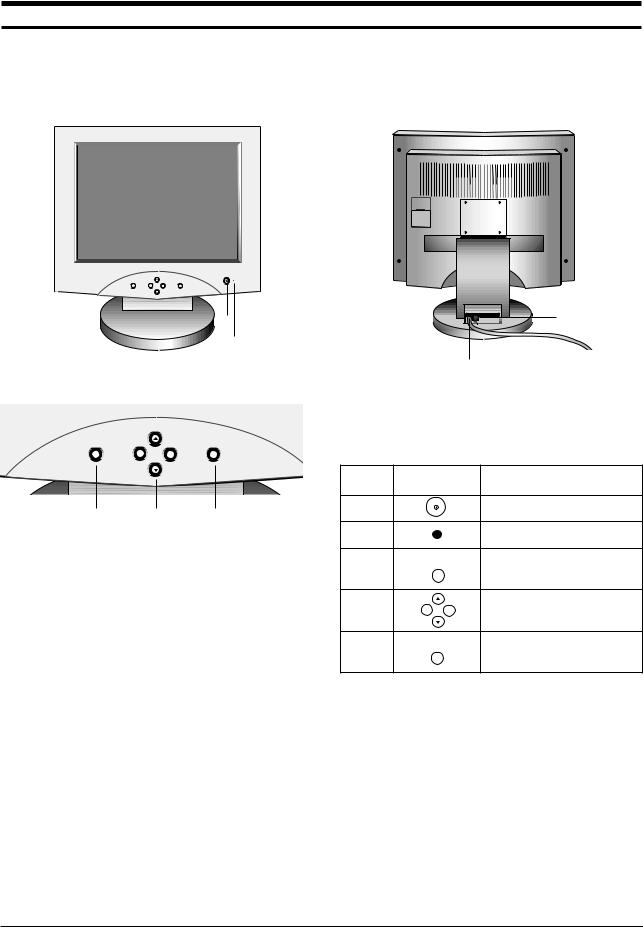
4 Operating Instructions
4-1 Control and Connectors
4-1-1 SyncMaster 331TFT/531TFT |
|
1 |
Power Port |
|
|
|
2 |
Signal Cable
4-2. Rear View
G
EXIT |
|
MENU |
- |
+ |
Table 4-1. Front Panel Controls |
|
|
Location |
Symbol |
Description |
3 |
4 |
1 |
|
Power Button |
5 |
|
|
2
Figure 4-1. Front View and Control
3 |
EXIT |
EXIT Button |
|
||
4 |
- + |
Up / Down / + / – Buttons |
5 |
MENU |
|
MENU Button
SyncMaster 33*TFT/53*TFT |
4-1 |
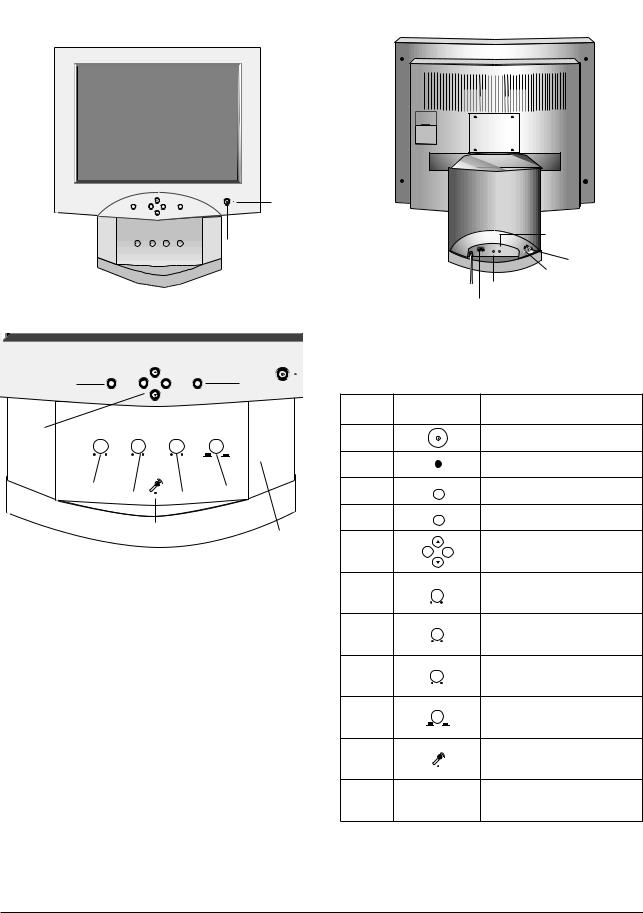
4 Operating Instructions
4-1-2 SyncMaster 330TFT/530TFT
SAMSUNG |
+ |
|
2 |
- |
MENU |
||
EXIT |
|
|
Audio in port
1 |
MIC |
AUDIO |
|
OUT |
IN |
Headphone jack
External microphone jack
Microphone out port
Power port
|
|
|
|
Figure 4-4. Rear View |
SAMSUNG |
|
|
|
|
EXIT |
|
|
MENU |
Table 4-2. Front Panel Controls |
3 |
- |
+ |
4 |
|
|
|
|
|
Location |
Symbol |
Description |
|
5 |
ON/OFF |
|
|
|
|
|
|
|
VOLUME |
BASS |
TREBLE |
MIC |
1 |
|
|
Power Button |
|
|
|
|
|
|
|
|
||
|
MIN MAX |
MIN MAX |
MIN |
|
|
|
|
Power Indicator |
|
6 |
|
|
9 |
3 |
EXIT |
Menu Button |
|
|
7 |
8 |
|
|
||||
|
|
|
|
|
|
|
||
|
|
|
|
|
4 |
MENU |
Exit Button |
|
|
|
10 |
|
|
|
|
||
|
|
|
|
11 |
|
|
|
|
|
|
|
|
|
|
|
|
|
|
|
|
|
|
5 |
- |
+ |
Up / Down / + / – Buttons |
|
Figure 4-3. Front View and Control |
|
VOLUME |
|
||||
|
|
|
|
|
|
ON/OFF |
|
|
|
|
|
|
|
6 |
|
|
Audio On / Off & Volume Buttons |
|
|
|
|
|
|
MIN |
MAX |
|
|
|
|
|
|
|
BASS |
|
|
|
|
|
|
|
7 |
|
|
Bass Button |
|
|
|
|
|
|
MIN |
MAX |
|
|
|
|
|
|
|
TREBLE |
|
|
|
|
|
|
|
8 |
|
|
Treble Button |
|
|
|
|
|
|
MIN |
MAX |
|
|
|
|
|
|
|
MIC |
|
|
|
|
|
|
|
9 |
|
|
Microphone On / Off Button |
|
|
|
|
|
|
ON |
OFF |
|
|
|
|
|
|
10 |
|
|
Microphone |
|
|
|
|
|
11 |
|
|
Amplified Stereo Speakers |
4-2 |
SyncMaster 33*TFT/53*TFT |
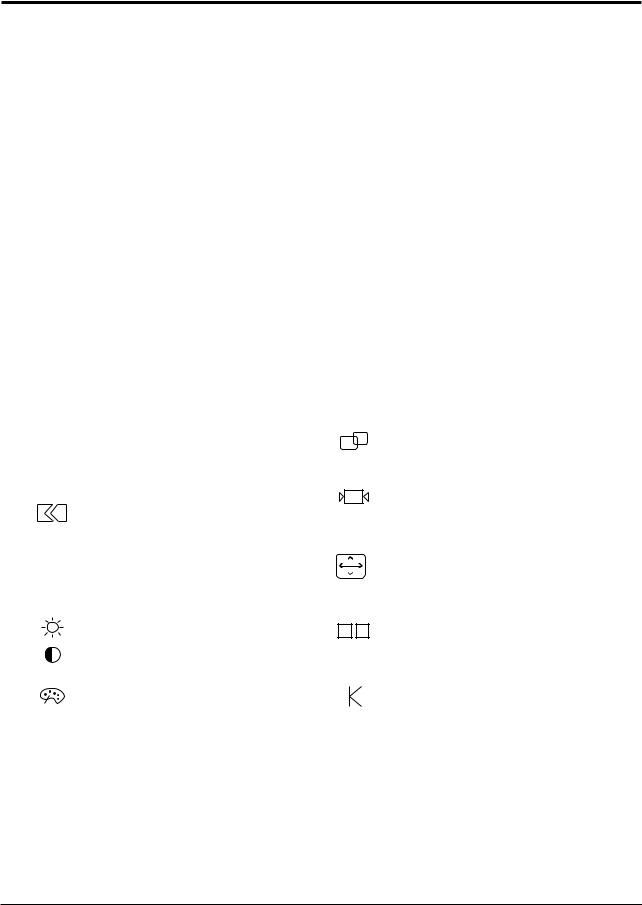
4 Operating Instructions
4-2 Microprocessor Controls and Functions
This monitor has no “service only” micom controls. Should there be a problem with the microprocessor, replace the entire circuit board. There are, however, user accessible adjustment features that are described below.
This monitor has factory preset display settings for each of the signals listed in the standard display modes Timing Chart (see pages 3-3 and 3-4). As a result, when the monitor senses one of the standard signal timings, it automatically adjusts to an optimum size and position.
However, the user may wish to adjust the monitor to their own preferred settings rather than use those preset at the factory. The monitor saves up to 16 user defined settings.
4-2-1 OSD Window
The adjustable features described below all use the on-screen menu system.
1.Push the button to open the display the onscreen menu.
2.Use the  or
or  button to change an adjustment icon, use the button to highlight an adjustment icon, then use the + or – buttons to make the adjustments.
button to change an adjustment icon, use the button to highlight an adjustment icon, then use the + or – buttons to make the adjustments.
3.To select another adjustment on the same
screen, use the  or
or  button to move to the next selection.
button to move to the next selection.
4.When you are done making adjustments on an adjustment icon, push the EXIT button.
5.When you are done making all adjustments, push the EXIT button.
Table 4-3 shows the adjustment types and their icons.
Table 4-3. Available adjustments
Icon |
Description |
|
Adjustment Range |
Icon |
|
Description |
Adjustment Range |
||||||
|
|
|
|
|
|
|
|
|
|
|
|
|
|
|
|
IBM |
VGA1/70 Hz |
0-100 |
|
|
|
|
|
|
|
Position |
0 ~ 100 |
|
|
|
|
740-860 |
|
|
|
|
|
|
|
Horizontal |
|
|
|
|
|
|
|
|
|
|
|
|
0 ~ 100 |
||
|
|
|
|
|
|
|
|
|
|
|
|
Vertical |
|
|
|
|
VGA2/70 Hz |
0-100 |
|
|
|
|
|
|
|
||
|
|
|
|
|
|
|
|
|
|
|
|||
|
|
|
|
|
|
|
|
|
|
|
|
||
|
|
|
|
840-960 |
|
|
|
|
|
|
|
Auto Reset |
|
|
|
|
|
|
|
|
|
|
|
|
|
Auto Adjustment |
No/Yes |
|
Image Lock |
|
VGA3/60 Hz |
0-100 |
|
|
|
|
|
|
|||
|
|
|
|
|
|
|
|
|
Geometry |
No/Yes |
|||
|
|
|
740-860 |
|
|
|
|
|
|
|
|||
|
Fine |
|
|
|
|
|
|
|
|
|
Color |
No/Yes |
|
|
|
|
|
|
|
|
|
|
|
|
|||
|
VESA |
SVGA/56 Hz |
0-100 |
|
|
|
|
|
|
||||
|
Coarse |
|
|
|
|
|
|
|
|
|
|||
|
|
|
|
|
|
|
|
|
|
||||
|
|
|
964-1084 |
|
|
|
|
|
|
|
Image Size |
|
|
|
|
|
|
|
|
|
|
|
|
|
x1, x2, x4, x8 |
||
|
|
|
SVGA/60 Hz |
0-100 |
|
|
|
|
|
|
|
Zoom |
|
|
|
|
|
|
|
|
|
|
|
Normal/Expand |
|||
|
|
|
|
996-1116 |
|
|
|
|
|
|
|
Display Size |
|
|
|
|
|
|
|
|
|
|
|
|
|
||
|
|
|
XGA/60 Hz |
0-100 |
|
|
|
|
|
|
|
|
|
|
|
|
|
|
|
|
|
|
|
Misc. |
|
||
|
|
|
|
1284-1404 |
|
|
|
|
|
|
|
|
|
|
|
|
|
|
|
|
|
|
|
|
Language |
|
|
|
|
|
|
|
|
|
|
|
|
|
|
|
|
|
|
|
|
|
|
|
|
|
|
|
|
|
|
|
Brightness |
0 ~ 100 |
|
|
|
|
|
|
|
|
Menu Position |
0 ~ 100 |
|
|
|
|
|
|
|
|
|
|
|
|
|
Menu Display Time |
0 ~ 100 |
|
|
|
|
|
|
|
|
|
|
|
|||
|
Contrast |
0 ~ 100 |
|
|
|
|
|
|
|
||||
|
|
|
|
|
|
|
|
|
Display Mode |
|
|||
|
|
|
|
|
|
|
|
|
|
|
|
|
|
|
Color Control |
|
|
|
|
|
|
|
|
|
|
Color Temperature |
|
|
Red |
0 ~ 100 |
|
|
|
|
|
|
|
|
Mode1 |
|
|
|
Green |
0 ~ 100 |
|
|
|
|
|
|
|
|
Mode2 |
|
|
|
Blue |
0 ~ 100 |
|
|
|
|
|
|
|
|
Mode3 |
|
|
|
|
|
|
|
|
|
|
|
|
|
|
|
|
SyncMaster 33*TFT/53*TFT |
4-3 |
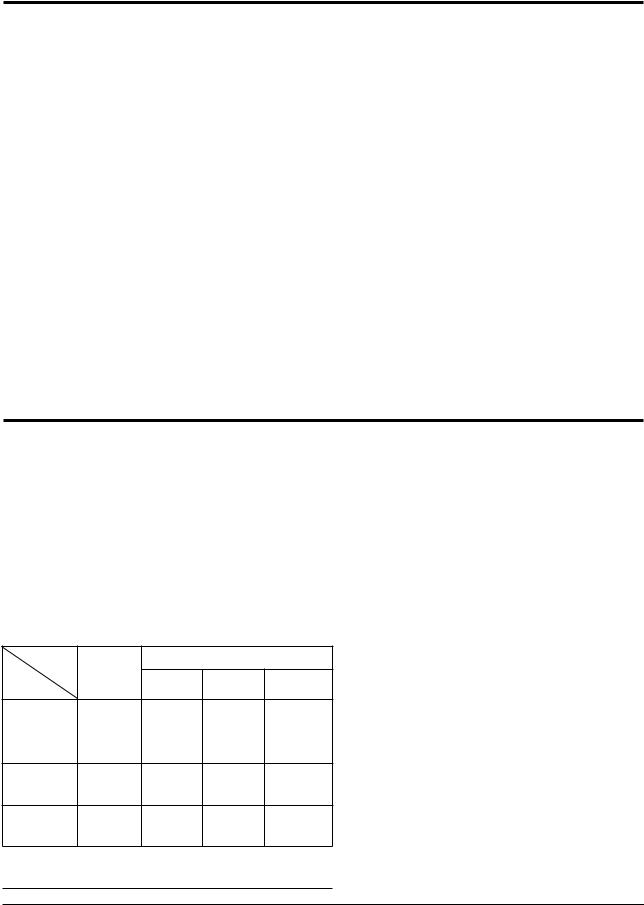
4 Operating Instructions
4-3 Audio Controls
Your LCD monitor provides four audio control buttons located on the front of the stand.
4-3-1 Audio Adjustments
To access the on/off, volume, bass and treble functions push the appropriate blue control button until it pops out then turn it to the right or left to adjust the function.
Function |
Effect of Control Movement |
|
Name |
Left |
Right |
|
|
|
Audio On/Off |
Off |
On |
and Volume |
Decrease volume |
Increase volume |
|
|
|
Bass |
Decrease Low sounds |
Increase low sounds |
|
|
|
Treble |
Decrease high sounds |
Increase High sounds |
|
|
|
Your LCD monitor includes an internal microphone which you can turn On or Off using the rightmost control of the Audio controls.
Function |
Effect of Control Movement |
||
Name |
In |
Out |
|
|
|
|
|
Audio On/Off |
Off |
On |
|
and Volume |
|||
|
|
||
|
|
|
|
4-4 Power Management System
This monitor has a built-in power management system called PowerSaver. This system saves energy by switching your monitor into an off mode when it has not been used for an certain amount of time.
Note 1: This monitor automatically returns to normal operation when horizontal and vertical sync return. This occurs when you move the computer's mouse or press a key on the keyboard.
This system operates with a VESA DPMS |
|
Note 2: This monitor is EPA ENERGY STAR® |
||||
compliant video card installed in your computer. |
compliant and NUTEK compliant when |
|||||
You use a software utility installed on your |
|
used with a computer equipped with |
||||
computer to set up this feature. See the table |
|
VESA DPMS functionality. If your |
||||
below for details. |
|
|
|
computer system cannot support a display |
||
Table 4-4. Display Power Management Signaling (DPMS); 13.3” |
power management function, you can |
|||||
purchase an optional DPMS software |
||||||
|
|
|
|
|
||
State |
Normal |
Power saving function EPA/NUTEK |
program to enable the power saving |
|||
function. Please contact Samsung or your |
||||||
|
|
|
|
|||
Items |
Operation |
Stand-By |
Suspend Mode |
Power Off Mode |
dealer for more information. |
|
|
Mode |
Position A |
Position B |
|||
Horizontal Sync |
Active |
Inactive |
Active |
Inactive |
Note 3: For energy conservation, turn your |
|
Vertical Sync |
Active |
Active |
Inactive |
Inactive |
monitor OFF when it is not needed, or |
|
when leaving it unattended for long |
||||||
Video |
Active |
Blanked |
Blanked |
Blanked |
||
periods. |
||||||
Power |
|
|
Amber |
Amber |
|
|
Green |
Amber |
Blinking |
Blinking |
Note 4: Audio Part is operated separately by |
||
Indicator |
||||||
|
|
(0.5 sec) |
(1 sec) |
control button. |
||
Power |
40 W (max.) |
|
||||
Less than |
Less than |
Less than |
|
|||
Consumption/hr |
30 W |
|
||||
5 W |
5 W |
5 W |
|
|||
(13.3”) |
(nominal) |
|
||||
|
|
|
|
|||
Power |
45 W (max.) |
Less than |
Less than |
Less than |
|
|
Consumption/hr |
35 W |
|
||||
5 W |
5 W |
5 W |
|
|||
(15”) |
(nominal) |
|
||||
|
|
|
|
|||
4-4 |
|
|
|
|
SyncMaster 33*TFT/53*TFT |
|
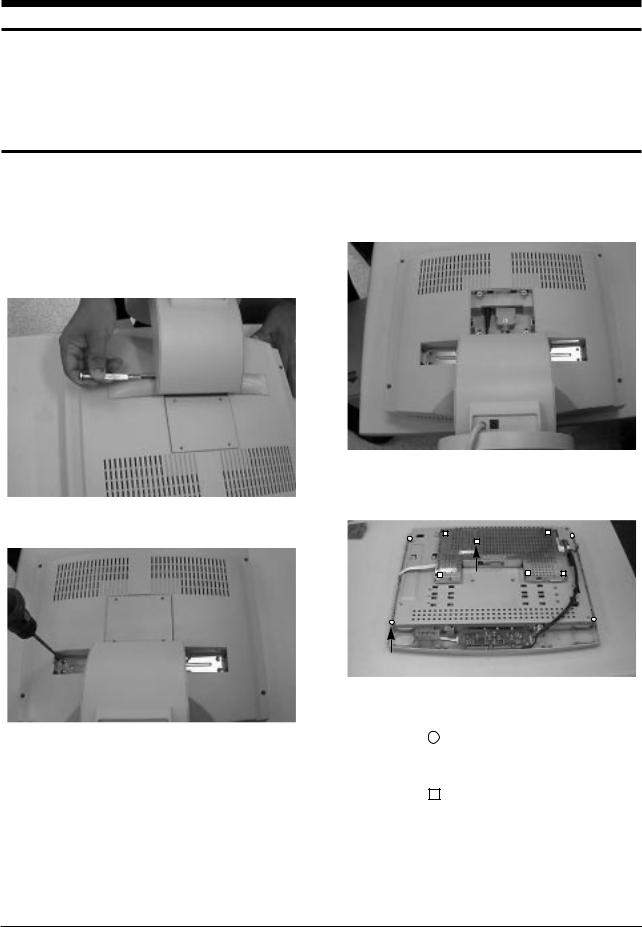
5 Disassembly and Reassembly
This section of the service manual describes the disassembly and reassembly procedures for the SyncMaster 33*TFT/53*TFT monitors.
WARNING: This monitor contains electrostatically sensitive devices. Use caution when handling these components.
5-1 Disassembly
Cautions:1. Disconnect the monitor from the power source before disassembly.
2. Follow these directions carefully; never use metal instruments to pry apart the cabinet.
5-1-1 Removing the Stand |
5. Disconnect Power Cord and Signal Cable. |
1.Carefully push the edge of the hinge cap with a ‘–’ screw driver until the opposite end of the hinge cap releases.
Figure 5-1
2. Remove 4 screws in the hinge area.
Figure 5-2
3.Push the stand to the left side to release the hinge.
Caution:Be careful. Signal cable and power cable are still attached to the monitor.
4.Lift the stand away from the monitor until Vesa Cover is completely visible. And pry it off the back of the monitor.
Figure 5-3
5-1-2 Main Body Disassembly
Figure 5-4
1.Remove the 4 screws on the Rear Cover. (Marked: )
2.Remove Rear Cover from the Front Cover.
3.Remove 6 screws on the Shield. (Marked: )
4.Disconnect Inverter wire, Function PCB wire and Interface wire.
5.Remove the Main PCB Assembly.
SyncMaster 33*TFT/53*TFT |
5-1 |
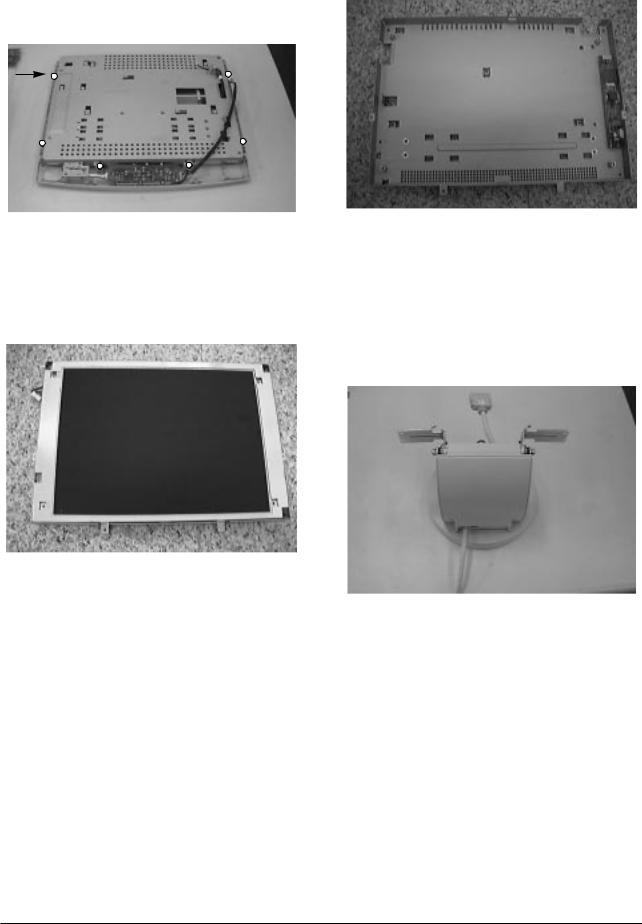
5 Disassembly and Reassembly
6.Remove 4 screws on the Rear Panel Bracket. (15” : 6 screws)
Figure 5-5
7.Remove the Bracket Assembly from the Front Cover.
8.Remove 1 screw on the Power PCB.
9.Remove Function PCB from locking area of Function Knob.
Figure 5-6
10.Remove 4 screws on the Shield of Panel.
11.Remove the Shield.
12.Disconnect the jack between Panel and Inverter PCB.
13.Remove Rear Bracket.
Figure 5-7
14.Remove 2 screws between Rear Bracket and Inverter PCB.
15.Remove the Interface wire on the Rear Side of Panel.
5-1-3 Stand Disassembly
1.Stand the stand assembly with the base close to you.
Figure 5-8
5-2 |
SyncMaster 33*TFT/53*TFT |
